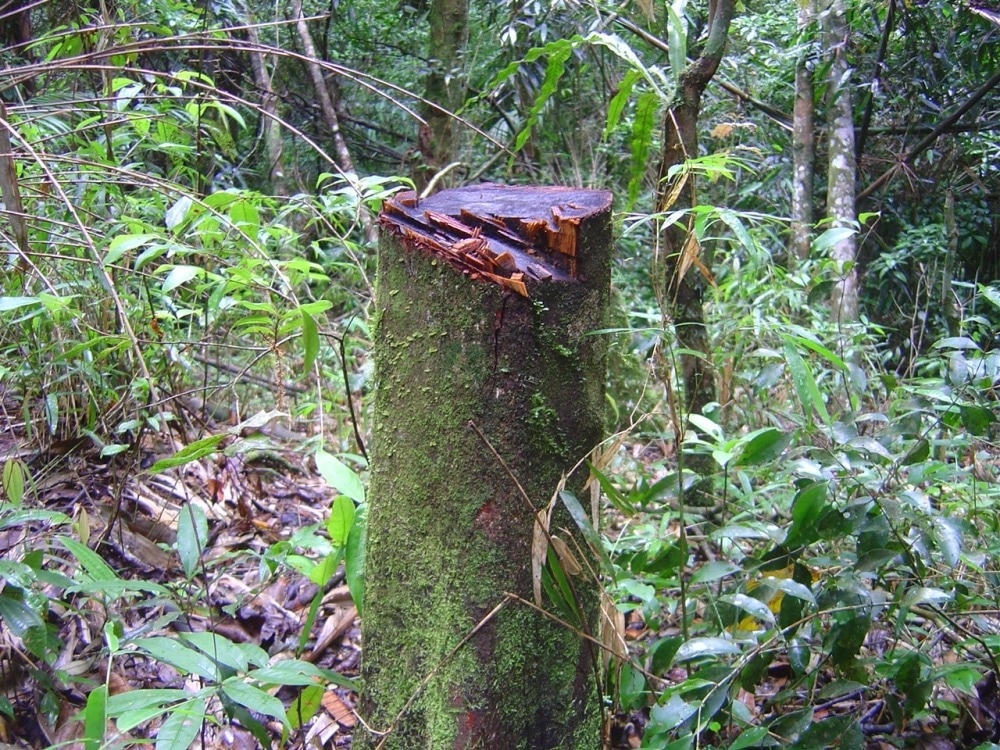Reviewed by Mila PereraSep 14 2022
The innumerable advantages of native forests include the ability of tree biomass to capture large volumes of carbon, which can offset greenhouse gas emissions into the air.
 Conservation of CO2 stocks in the biome is highly affected by forest degradation, which could lead to at least 30% higher emissions than those produced by climate change. The warning comes from a paper by Brazilian scientists published in Science Advances (example of human impact on Atlantic Rainforest: selective logging.) Image Credit: Renato A.F. Lima
Conservation of CO2 stocks in the biome is highly affected by forest degradation, which could lead to at least 30% higher emissions than those produced by climate change. The warning comes from a paper by Brazilian scientists published in Science Advances (example of human impact on Atlantic Rainforest: selective logging.) Image Credit: Renato A.F. Lima
An article published in the journal Science Advances describes a novel examination of a large dataset intended to elucidate the theory of carbon sequestration, a strategic subject in the dialogue concerning global climate change.
“We still know little about the factors that can lead forests to store more or less carbon,” said Renato Augusto Ferreira de Lima, one of the study’s ten authors. Lima is affiliated with the Ecology Department at the University of São Paulo's Institute of Biosciences (IB-USP) in Brazil and is presently a scientist at the Center for Biodiversity Synthesis and Analysis (CESAB) in Montpellier (France).
We used a large forest inventory database to see which factors are uppermost in explaining current levels of carbon storage in the Atlantic Rainforest. We found that factors relating to the different types of human impact on the forest are key, with two to six times the significance of factors such as climate, soil, and the characteristics of the tree species in the forest.
Renato Augusto Ferreira de Lima, Study Author, Ecology Department, Institute of Biosciences, University of São Paulo
Back-pedaling the effects of human activity on Atlantic Rainforest remnants would thus be the ideal approach to boost forest carbon stocks. Approximately 50% of the Brazilian population presently resides in areas formerly occupied by the ecosystem.
According to Marcela Venelli Pyles, the study’s first author and a Ph.D. candidate in applied ecology affiliated with the Ecology and Conservation Department of the Federal University of Lavras (UFLA) in Minas Gerais, Brazil, the preservation of carbon stocks in the Atlantic Rainforest is reliant on forest degradation, which can result in carbon losses at least 30% worse than any future climate change.
Furthermore, emissions from forest degradation can hamper conservation efforts vowed in climate change mitigation contracts, such as the Aichi targets and REDD+.
REDD is an acronym for “Reducing Emissions from Deforestation and forest Degradation”. The plus sign in REDD+ translates as “the role of conservation, sustainable management of forests and enhancement of forest carbon stocks in developing countries,” according to the UN Framework Convention on Climate Change, which implemented this tool to financially reward developing nations for mitigation efforts taken to deal with climate change.
The Aichi Biodiversity Targets include 20 international targets for biodiversity loss reduction to be fulfilled by 2020, signed on at the 10th Conference of the Parties to the UN Convention on Biological Diversity (CBD), conducted in Nagoya, Aichi Prefecture, Japan, in 2010.
For instance, tree damage and death due to disturbances in Atlantic Rainforest fragments as a result of canopy opening and microclimate deviations can result in carbon losses of nearly 10.50 metric tons per hectare, equivalent to an emission of 15.24% of the carbon trapped in one hectare. In comparison, carbon storage protection and improvement can accomplish gains of 12.02 tons per hectare, boosting storage by 17.44%.
Warmer Climate
In addition to degradation owing to human activity, the research also examined how climate change, principally surging temperatures and water stress, jeopardizes carbon storage in the Atlantic Rainforest.
If global warming is restricted to 1.5 °C above pre-industrial levels, as the Intergovernmental Panel on Climate Change (IPCC) recommended, the Atlantic Rainforest alone will discharge 3.53 tons per hectare (+ 5.12%).
But if the average temperature continues to rise at the current rate, carbon emissions could exceed 9.03 tons per hectare [+ 13.11%].
Marcela Venelli Pyles, Study First Author and Ph.D. Candidate, Applied Ecology, Ecology and Conservation Department, Federal University of Lavras
The article also argues that climate change alleviation actions involving forest restoration could gain from the addition of species with heavier seeds, higher wood density, and bigger leaves. Carbon conservation programs should consider methods used to measure carbon stocks.
The difference between methodologies used in the field can lead to errors in estimating carbon, entailing misinterpretation and inefficient climate change mitigation measures.
Marcela Venelli Pyles, Study First Author and Ph.D. Candidate, Applied Ecology, Ecology and Conservation Department, Federal University of Lavras
The article also pinpoints a “weak relationship” between taxonomic and functional diversity and carbon storage in the Atlantic Rainforest. Based on this, it deduces that conservation strategies concentrating only on carbon may fail to safeguard biodiversity and that independent incentive mechanisms to preserve species should be investigated.
According to Lima, the knowledge gained on the Atlantic Rainforest provides potential awareness for other forests worldwide concerning nature-centric solutions to fight the hostile effects of human activity and climate change.
The article is also signed by Luiz Fernando Silva Magnago (Federal University of Southern Bahia), Bruno X. Pinho (Federal University of Pernambuco), Gregory Pitta (USP), André L. De Gasper and Alexander C. Vibrans (Regional University of Blumenau), and Vinícius Andrade Maia, Rubens Manoel dos Santos and Eduardo van den Berg (UFLA).
The research received support from FAPESP, which funded Lima’s postdoctoral research.
Journal Reference
Pyles, M. V., et al. (2022) Human impacts as the main driver of tropical forest carbon. Science Advances. doi.org/10.1126/sciadv.abl7968.